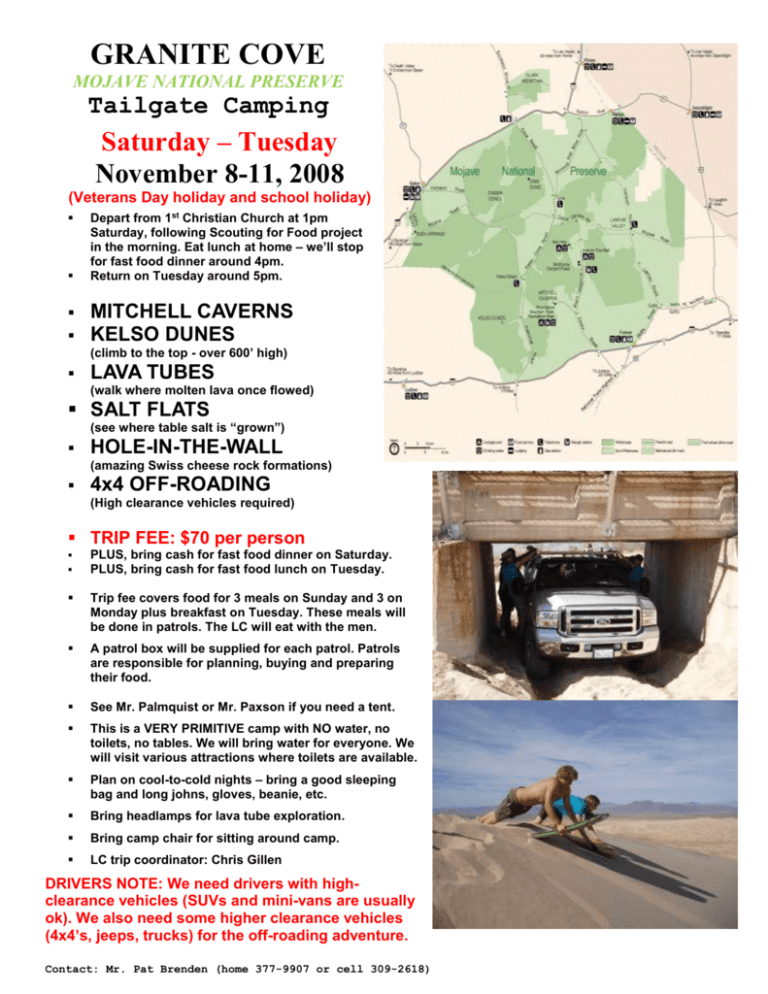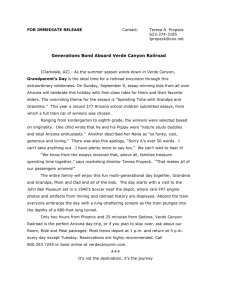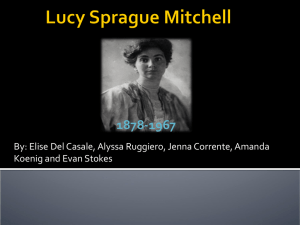HOLE-IN-THE-WALL (amazing Swiss cheese rock formations)
advertisement

GRANITE COVE MOJAVE NATIONAL PRESERVE Tailgate Camping Saturday – Tuesday November 8-11, 2008 (Veterans Day holiday and school holiday) Depart from 1st Christian Church at 1pm Saturday, following Scouting for Food project in the morning. Eat lunch at home – we’ll stop for fast food dinner around 4pm. Return on Tuesday around 5pm. MITCHELL CAVERNS KELSO DUNES (climb to the top - over 600’ high) LAVA TUBES (walk where molten lava once flowed) SALT FLATS (see where table salt is “grown”) HOLE-IN-THE-WALL (amazing Swiss cheese rock formations) 4x4 OFF-ROADING (High clearance vehicles required) TRIP FEE: $70 per person PLUS, bring cash for fast food dinner on Saturday. PLUS, bring cash for fast food lunch on Tuesday. Trip fee covers food for 3 meals on Sunday and 3 on Monday plus breakfast on Tuesday. These meals will be done in patrols. The LC will eat with the men. A patrol box will be supplied for each patrol. Patrols are responsible for planning, buying and preparing their food. See Mr. Palmquist or Mr. Paxson if you need a tent. This is a VERY PRIMITIVE camp with NO water, no toilets, no tables. We will bring water for everyone. We will visit various attractions where toilets are available. Plan on cool-to-cold nights – bring a good sleeping bag and long johns, gloves, beanie, etc. Bring headlamps for lava tube exploration. Bring camp chair for sitting around camp. LC trip coordinator: Chris Gillen DRIVERS NOTE: We need drivers with highclearance vehicles (SUVs and mini-vans are usually ok). We also need some higher clearance vehicles (4x4’s, jeeps, trucks) for the off-roading adventure. Contact: Mr. Pat Brenden (home 377-9907 or cell 309-2618) MOJAVE NATIONAL PRESERVE - Attractions EAST MOJAVE DESERT The East Mojave represents a time scale almost beyond human comprehension. From the granite formations of Mesozoic Age – more than 150 millions years old – to young 10 million year old Cenozoic rocks, the igneous, metamorphic and sedimentary rocks reveal a long and complex past. During more recent geological time, some 20,000 years ago, this land was covered with abundant waters, rivers and lakes. Marshlands, grassy valleys and stands of pines, junipers and oaks sheltered a wide variety of mammals and birds. Fossil remains of extinct sloth, camels, bison and enormous prehistoric horses are evidence of a very different land than we see here today. But approximately 11,000 years ago, the weather became drier and warmer; as the lakes dried up, the forests and grasslands shriveled away and died. With their food supply depleted, many of the animals also perished. Indians seeking available food and water migrated throughout the area. In true Darwinian fashion, all life in the rapidly growing desert became a matter of survival of the fittest. As life forms have changed over the ages, so too, has the land. Hot, dry winds have eroded mountains into grains of sand, and then built them up again as sand dunes. Runoff from irregular, but violent thunderstorms has carved canyons and washes; debris carried down from the mountains by the turgid waters has built up fanlike formations. Volcanic activity has created cinder cones, spectacular rock formations and lava flows, and geologic movement along faults has crumpled, folded and tipped this stratified land. These natural forces have created dramatic geographic features, unique in all the world. BARSTOW Founded in 1888 when the Santa Fe Railroad arrived. Located on the Mojave River, the area had already become a thriving mining center when silver was discovered six miles north in the Calico Mountains in 1882. Named for the president of the Santa Fe Railroad, William Barstow Strong, Barstow thrived along with the nearby successful mining towns of Daggett and Calico. However, as the silver began to play out in the nearby mines, Daggett and Calico began to die, but Barstow grew as it became a busy rail center. At the turn of the century, rail travel was considered glamorous and in 1911 the Fred Harvey Company opened up the Casa Del Desierto where gourmet cuisine was served on fine china to the many travelers along the rails. Comfortable, luxurious rooms rested the weary rail travelers as the Harvey Girls served food and provided information. The Harvey House had a reputation for friendliness and hospitality and became the focus not only for travelers but also for locals. Barstow’s Harvey House was equipped with a full ballroom and was the site for many of the town’s dances and social events. At one time, Barstow’s main street was right in front of the train station and the Harvey Hotel. However, in the 1920’s the Santa Fe Railroad literally bought the whole street a moved it to where it is today. The grand opening for the “new” Main Street was July 4, 1925. As the automobile began to replace rail travel, Route 66 traveled Barstow’s “new” Main Street barreling straight through the middle of town, and the Harvey House remained a popular stopping point. However, when the Santa Fe Railroad started serving meals on the trains, the Harvey Houses became shadows of their former selves. The building was then used mainly for a machine shop, with a cafeteria and a small Amtrak ticket office. Before long, the Casa Del Desierto was abandoned altogether. In the late 1980’s, Santa Fe Railway decided to tear down the old Harvey House until an outcry was raised by local citizens and historians. The old building was saved by the City of Barstow and restoration began. The Casa Del Desierto was re-dedicated in 1999 and is now home to the Greyhound and Amtrak stations, several arts groups, the Mother Road Route 66 Museum, and now the Western America Railroad Museum. As you roll through Barstow along Route 66, which is today’s Main Street in Barstow, keep your eyes open for the Barstow Station on your right at 1611 East Main Street. The Barstow Station includes gift shops and a famous McDonalds built entirely from railroad passenger cars where you can see a great collection of vintage photographs. Barstow Station has undergone three iterations during its time. Before Barstow station was built, the first McDonalds building was where the currant parking lot is now and the railroad cars were the front with parking spaces where the drive in area is now. They used to cook the food in the old McDonalds and had “runners” hired that took the food to the first Barstow station. LAVA TUBES (at Pisagh Crater abandoned lava rock mine) Lave tubes are formed when swift-moving lava cools more quickly in the middle than on the outside, thus resulting in cave-like formation. Tube exploration requires extreme caution and bring a headlamp or flash light! SALT FLATS (Bristol Dry Lake) Ever wonder where that salt at your table comes from? Well, Bristol Dry Lake is one of the sources. With 60 million tons in reserve, you will be able to salt your food for some time to come. Bristol Lake is a dry lake bed in the desert near the Mojave National Preserve. The lake is still actively mined. Bristol Lake is located 3 miles east of Amboy with an elevation of about 600 feet. The mineral halite, (sodium chloride - NaCl), occurs as a crystal body underlying the lake. The surface of the playa lake is composed of sand, clay, and gypsum. Two interesting materials present are sulfates and halite. The surface material is thinnest at the southern portion of Bristol Dry Lake and thickens to the north. In the southern portion of the dry lake, the overburden does not exceed 3 feet in thickness. The crystal body is of high-grade halite, crystallized in cubes, filled with brine that is principally calcium chloride or Salt. Some mud, largely of volcanic ash origin, is found with the salt body. The salt body has an average thickness of 5 feet. Underlying this salt body is a bed of bluish clay 8 to 10 feet in thickness and then another bed of salt reported to average 5 feet in thickness. The lake is covered by a few inches of water in the winter, but for the most part it's dry and very salty. Contact: Mr. Pat Brenden (home 377-9907 or cell 309-2618) MOJAVE NATIONAL PRESERVE – Attractions (CONTINUED) KELSO DEPOT In 1906, the railroad between Salt Lake City and Los Angeles was completed, leading to the establishment of the tiny town of Kelso where reliable sources of water made it an ideal stopping point for trains. Steam locomotives that were still in wide use at the time took on boiler water in Kelso before they chugged up the long Cima grade; a climb of 2,000 feet in eighteen miles. The Kelso Depot was built by the Los Angeles and Salt Lake Railroad in 1924 and was originally known as the Kelso Club House and Restaurant. In 1994, it was turned over to the National Park Service with the creation of the Mojave National Preserve. It was recently renovated and now houses the official Visitor’s Center for the Preserve. KELSO DUNES This 45-square mile formation of magnificently sculpted sand dunes is among the most extensive dune fields in the West, reaching more than 700 feet high in some places. The dunes are built up from particulate remains of mountains worn away long ago. Prevailing winds carry sand particles from the Mojave River Sink, across the Devil’s Playground, to be deposited where further movement is blocked by the Providence Mountains to east. Kelso Dunes are called “booming dunes” because of the low vibrational sounds that are created when the sand slides under foot. An old story tells of a teamster who started off across the dunes with a wagonload of whiskey to replenish the supplies of the saloons in Kelso. A violent sandstorm arose and forced the wagonmaster to unhitch his team and wait out the storm. But, when he returned to reclaim his property with its important contents, it was nowhere to be found. Legend has it that the sounds that can be heard coming from the dunes on cold, clear nights are really the celebrations of the ghosts of the old teamster and his friends, who have finally located their precious load and are reveling in their discovery. The dunes support more than 100 varieties of plant life including desert primrose, sand verbena, and native grasses. Mesquite and creosote grow on the lower dunes. Animals inhabiting the dunes include birds, rodents, sidewinder rattlesnakes, lizards, and kit foxes. A hike to the top and back requires 2-3 hours. The most dramatic views occur at sunrise and sunset. HOLE-IN-THE-WALL (elevation 4,200) There is a campground here and to the east is the Woods Mountains which features Rustlers Canyon, an out of the way place where cattle rustlers and various outlaws once hid out from lawmen. A visitor’s center near the campground offers much information about the area. Immediately west of the campground is a maze of volcanic rocks that descend first into Banshee Canyon and then into a large open desert box canyon named Wildhorse Canyon. A series of iron rings that have been set into the rock, allow hikers to descend into Banshee Canyon and then into Wildhorse Canyon, which features eroded rock formations, which look like swiss cheese. Silly photo opportunities abound. Although one would suspect that Hole-in-the-Wall got it’s name because of the swiss cheese rock formations of Wildhorse Canyon, such is not the case. The story goes that, in the 1880’s, a couple of ranch hands from a nearby ranch observed a pair of Indians leading a few head of cattle. Suspecting that these Indians were stealing the cattle, the ranch hands chased the Indians into Wildhorse Canyon, which they believed to be a dead-end. To their amazement, the Indians scrambled up Banshee Canyon and disappeared, seemingly right into the wall of rock. The ranch hands concluded that the Indians must have found a hole in the wall. Hole-in-the-Wall rocks aha violent past, geologically speaking. Some 18 million years ago, a volcano in the Woods Mountains erupted and spewed ash and rocks, some rocks as large as 60 feet across. Hot ashes cremated every living thing in the area; countless plant and animal fossils lie entombed beneath the surface. MITCHELL CAVERNS Mitchell Caverns are limestone caves that feature a wide variety of formations. Trips through the caverns are conducted by guided tours only and last about 1 1/2 hours. Although the tour is not strenuous, there is a half-mile walk to the cave entrance from the visitor center and another half-mile walk through the caverns on uneven ground. The area became a California State Park in 1956 and still contains the only limestone caves in the California State Park system. Mitchell Caverns are primarily the result of sedimentary limestone and metamorphosed limestone (marble) being dissolved by ground water high in carbonic acid content. After the dissolution, caverns were formed; the continued dripping of highly mineralized ground water into the caverns produced stalactites (dripstone deposits extending downward from the ceiling) and stalagmites (dripstone deposits building upward in mound-form from the floor). Jack Mitchell was the first owner and promoter of Mitchell Caverns. The Caverns were hard to reach and there were little funds available to improve the roads. Jack had to improve the roads and build the rock facilities that are now used by the Park Service. Even after opening the Caverns to the public, Jack Mitchell retained his interest in attempting to locate silver and other valuable deposits. The location of prospect holes and tunnels that he dug in this search, many along the Caverns' trail, can still be seen but have been blocked off as a safety precaution. Mitchell Caverns consists of three basic caves that he called "El Pakiva," or the Devil's House; "Tecopa, " named for one of the last chiefs of the Shoshone Indians; and the deep and vertical "Winding Stair Cave," a dangerous cavern that is off-limits to the general public. For many years it was thought that the Caverns were no longer "living," which means stalactites and stalagmites were not "growing." But heavy rains in some recent years have brought back some signs of life. Mitchell Caverns have been the subject of a number of scientific studies because they contain unusual formations not found in most other limestone caves. Contact: Mr. Pat Brenden (home 377-9907 or cell 309-2618) MOJAVE NATIONAL PRESERVE – Attractions (CONTINUED) MITCHELL CAVERNS (CONTINUED) An account of Jack Mitchell's first descent into the "Winding Stair Cave" during the period of his early explorations would read like fiction. It was a chilling experience as he lowered himself into the unknown depths with the use of a "bosun's chair" that constantly turned in the darkness, causing him to virtually lose all sense of both time and direction. His signature on the cavern wall, dated July 1, 1931, indicates that he had penetrated this cave at least as far as the portion he called "Dog Leg Room." The Cave of the Winding Stair has been utilized as a training area for cave rescue teams under a program sponsored jointly by the California Department of Parks and Recreation, the County Sheriff's Department, and the National Park Service. In conducting the tours that Jack guided through the El Pakiva and Tecopa caverns, it was necessary to make a separate entrance into each cave. This was a situation that always bothered him, because he said that it "spoiled the tour." He told eveyone that he had always wanted to connect the two caverns with a tunnel that would provide a continuous excursion, but lack of financing prevented him from making this improvement. It was finally accomplished after his death, when the California Department of Parks and Recreation hired crews to do the work. With the added publicity that the State was able to provide, the annual count of visitors to the Caverns has increased dramatically since the Mitchell years. OTHER ATTRACTIONS in the area (no time to visit these on THIS trip… sorry guys) AMBOY CRATER This 250-foot-high crater is approximately 6,000 years old and one of the best examples in the Mojave Desert of a volcanic cinder cone. A footpath leads to the top of the cone where you can get a good view of the surrounding area. The hike to the Crater and back can take 2-3 hours. Late January through March are good times to see the wildflowers. LANFAIR VALLEY & GOVERNMENT HOLES (on Cedar Canyon Road, west of Lanfair Road) Located in Lanfair Valley which takes it’s name from Edwin Lanfair who was the first successful farmer, arriving in 1910 during a period of unusually wet weather in the area that lasted from 1860 through 1920. Lanfair raised bumper crops of wheat and barley which attracted other settlers to the area. But the shortage of water was a constant problem. Although two wells were established in Lanfair, many homesteaders chose instead to transport water from “Government Holes”, a few miles to the west. The burgeoning homesteader community was unwelcome by the ranchers who had inhabited the area before Lanfair’s arrival. Long simmering disputes over land and water rights eventually erupted in a Wild West shootout at Government Holes in 1925. That was the final blow for the homesteaders of Lanfair Valley; the post office and general store closed in 1926. NIPTON Founded in 1904 with the coming of the railroad. The town’s motto is “Where the past is present.” The town was purchased in 1984 by Gerald Freeman, a professional geologist, who is the “Mayor” of Nipton. He restored the hotel (Hotel Nipton) and store (Nipton Trading Post). Silent film star Clara Bow was a frequent guest at the hotel. On our trip in January of 2006, Mayor Freeman hosted a lunch for us and gave a talk about 1) the geology of the area, 2) his personal story, and 3) local lore. BAKER World’s Tallest Thermometer Root Beer Floats Gas Stations LAVA TUBE (on Aikens Mine Road, 5 miles north of Kelbaker Road) Lave tubes are formed when swift-moving lava cools more quickly in the middle than on the outside, thus resulting in cave-like formation. A ladder in the tube facilitates exploration but use caution and bring a flash light! Contact: Mr. Pat Brenden (home 377-9907 or cell 309-2618)




